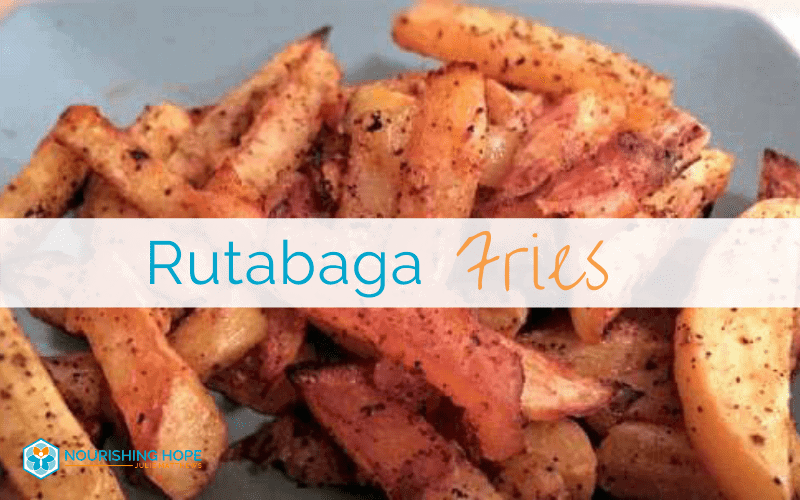
This is a great recipe because it’s compatible with so many diets.
To make it low salicylate or SAG, use ghee or sunflower oil.
For 100% dairy-free, avoid ghee.
For keto, eat sparingly.
Ingredients
- 3-4 Rutabagas
- Ghee or expeller-pressed coconut oil
- Salt
Directions
Preheat oven to 425 degrees.
Peel rutabagas, slice off top end where the greens attach. Slice into fries.
Melt ghee or coconut oil in a pan and toss raw rutabaga fries in oil until they are coated. Spread out into a single layer on a baking sheet. Sprinkle salt on fries (or any other seasoning you’d like, Primal Palate’s Meat and Potatoes spice blend is perfect on these fries, but if you need to be to low phenol stick with just salt).
Bake at 425 degrees for 35-45 minutes, turning fries occasionally for even browning.




I’m trying to figure out low salycilate cooking oil options help.
Re: Rutabaga Fries- On top Sunflr oil ismentioned (low salicylates?), in the recipe coconut oil appears (high in salicylates). Is there a list of foods -low in all three -amines, salicy’tes, and glutamine- thanks shvaG
Hi ShivaG, Here’s a short list of foods: https://nourishinghope.com/low-salicylate-low-amine-low-glutamate-recipes/. We have comprehensive food lists, recipes, meal planning options in my nutrition program for parents: https://nourishinghope.com/program/. All the best to you!
Hi,
Fellow nutritionist here. Thank you for all you are sharing here! I’m looking over your recipes to share with my low-FODMAPS eaters. My understanding is that coconut oil breaks down above 350 and therefore ghee or avocado oils are better choices for fat if roasting at high temperatures. Curious as to your thoughts on that one.
Warmly,
Regarding rutabagas and keto: rutabagas (like potatoes) become useful to keto dieters when used as a resistant starch–cooked, then cooled for 24 hrs. before eating. Think potato or rutabaga salad here. The inherent starch retrogrades in the cooling process, and can be re-heated the next day without loss of the retrograde. Therefore, potatoes, rutabaga, and even beans and pasta, can be enjoyed by ketoers after cooking and cooling at least 24 hrs., because these foods turn into resistant starches in the retrograde process. You may read (or have read) that leftovers are better the next day–in the case of starches, that’s true (from a blood sugar perspective).
*Caveat–monitor your blood glucose readings before and after consumption, because some people are (or become) resistant to resistant starch. My husband is one of them–his blood sugar goes higher after consumption, and stays there. Mine, however, goes down (meaning the resistant starch is actually working for me). If the retrograde isn’t working for you, then avoid these foods.
Hi
Could you please help.
I am at a stage where I’m hyper allergic to esp glutamate, the net is very confusing, lots of contradictive food lists.
What is your opinion on organic olive oil, coconut oil, the greens of spring onions and leeks.
If you have a food list , sorry,
With regards Shanti
Shanti, I can’t give personal advice, so always consult with your healthcare professional. It depends what you are allergic to. One of the confusing parts might be that while (according to the Royal Prince Alfred Hospital food intolerance information) these foods are not listed high in glutamate, they are higher in other natural compounds like salicylates and amines. And some diets remove all of them, so that’s one area you may find contradictory information.